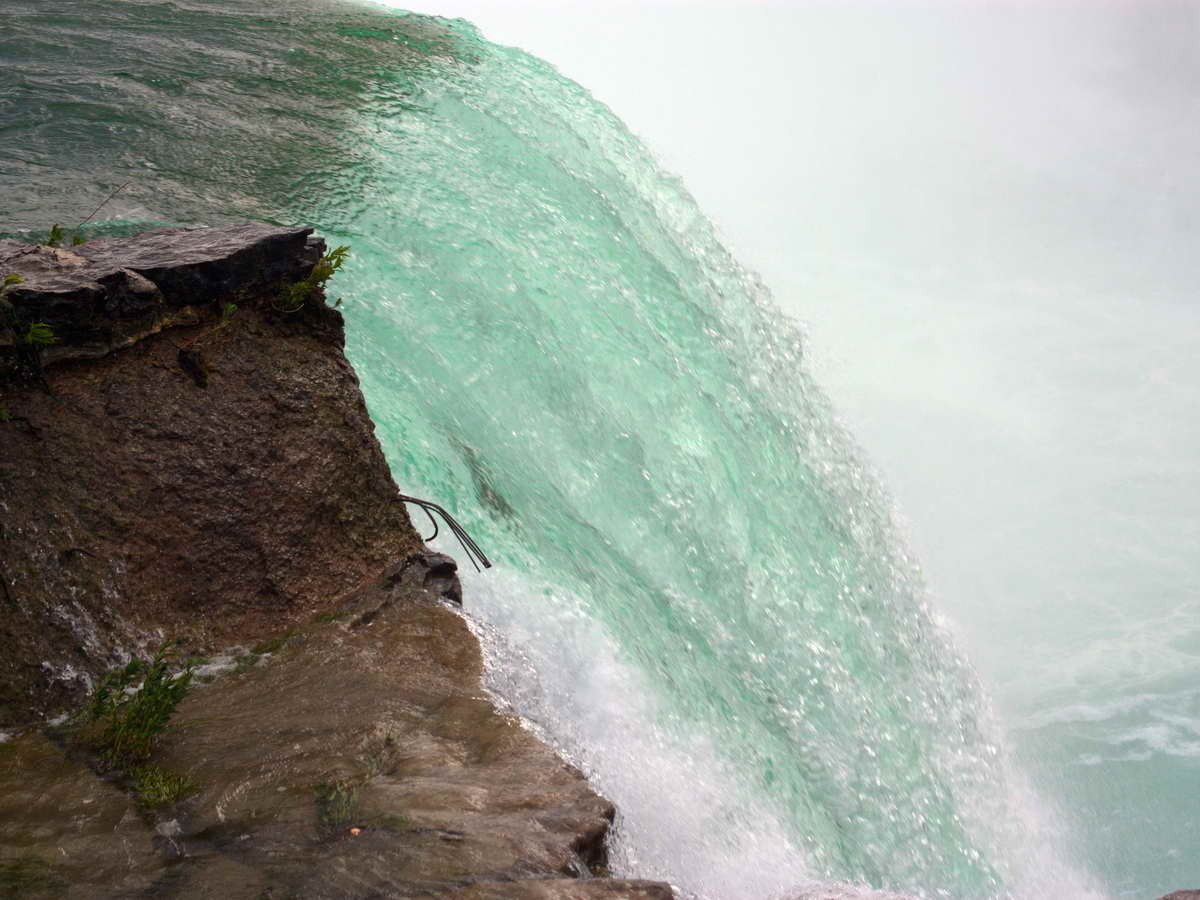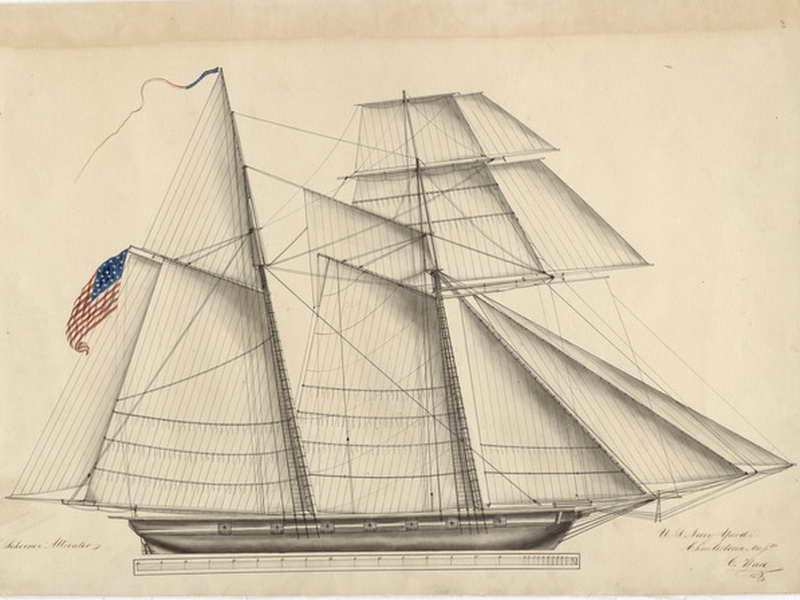A Buffalo, A Schooner, And Niagara Falls?
Niagara Falls has always depended on promotion to attract tourists to the area. People come to experience a small slice of the story of the falls that has been created and nurtured and embellished by countless business owners over the decades. Some visitors will be gleefully swept away as they buy into the themes of good food, romantic get-aways, people in barrels and daredevil high wire acts. Others will be disappointed by high prices, difficult parking, tacky tourist traps and thick crowds. But they will all have been drawn there by some collective notion of what Niagara Falls is supposed to be. Very few will know that a ship, full of doomed animals plunging over the edge of Niagara Falls to the cheers of thousands, was the beginning of this story.
For the October 6, 1827 edition of the Fall River Monitor newspaper, the editor had picked up a wire story from the month previous. It said that a Mr. Boniface, intent on turning a profit on Goat Island, just above Niagara Falls, had set up tables and attracted a large crowd to which he served food and drink. When an old sailing ship appeared, floating down the river towards the edge of the falls, “a wag raised the cry, ‘The schooner is coming!’ No time to be lost; the guests sprang from their meals and repaired with all possible speed to the opposite shore, leaving for the astonished Mr. Boniface an empty table as the only compensation for his trouble.” It seems he should have had his patrons pay in advance for it was this schooner they had come to see.
Tourism as an economy was in its infancy in the early 1800s. Much of life in North America was driven by a Puritan ethos of “work is good, play is bad”. Making money, or labouring away the hours, was respectable. Only morally suspect people would attend theater or sporting events (which were often violent), and the idea of spending money simply to travel and see some new place was not in fashion. Leisure pursuits and travel for pleasure were the “tools of the Devil”.
Of course, not everyone felt this way. A small but significant number of people with disposable income were no longer tied to long hours in a workplace. The idea of having leisure time and traveling, simply for the sake of travelling, was gaining appeal as railroads and steamships were opening up parts of North America that had been too hard to reach. For others, a day trip to some exotic place, which was likely to simply be “out of the city” they lived in, was a welcome escape from the soul crushing labour that took up roughly 70 hours of their lives each week.
By 1827 Niagara Falls had become a tourist destination. The influx of thousands of visitors each year fueled the growth of all the industries needed to support them and give them a good time. Regional newspapers ran advertisements from various hotel owners proclaiming the availability of accommodations should someone want to visit this wonder of the world. There was a highway that connected towns on the American side to the falls, and steamships regularly ran passengers to either shore at docks above the rapids.
Niagara Falls certainly fit the definition of “exotic” for the times. Visitors were thrilled with the sight of millions of gallons of greenish blue water going over the falls and crashing to the rocks below, in a violent and spectacular display of thundering sounds and mist choked air. Rickety bridges had been built from the American side across to Goat Island to view the falls up close, and a boat could be hired to bring people to either shore below the falls. On the Canadian side, guides were available for hire to bring thrill seekers behind the Horseshoe Falls themselves. The bluff, on both sides of the gorge, was already being developed with viewing areas, roads for easy access, hotels, bars, restaurants, shops and theaters.
Tourist areas always benefit from promotion and, to that end, a small group of local Niagara merchants and promoters came up with an idea to create a spectacle which would draw people in from all around Canada and the United States. All they needed was a ship, an old one would do, that they could let loose on the river and send over the Horseshoe Falls. It would be a unique sight. They could visualize the bow projecting over the falls, with the tall masts standing proudly. It would slowly pivot as more and more of it hung in the air 160 feet above the boiling river below. Perhaps, once it finally went over the edge, it would appear to be sailing down the torrent of water before being smashed to bits on the rocks below. It would be a sight that people would tell their grandkids about, and others would lie and claim to have been present.
At some point, one of these merchants must have asked, “Yeah, but how can we go bigger?”
They would purchase an old, condemned, and therefore inexpensive, sailing ship called the Michigan. She had started life in the British Navy during the war of 1812 and finished as a merchant vessel on the Great Lakes. For about a month before the event, the promoters ran advertisements in regional papers. The August 18, 1827 edition of the Buffalo Emporium and General Advertiser contained an ad that read in part, “It is our intention…to set adrift within a mile of the Falls at this place, the largest sail vessel on Lake Erie with a number of the hardiest animals such as Bears, Wolves, &ct…”
You read that right: “With a number of the hardiest animals…” That’s how they decided they could make the event even bigger. On the fateful day, the ship was to be crewed by a “bad dog” that bit a reporter, geese, raccoons, a fox, two bears and an old buffalo that people were assured was just a few days away from dying anyway. The promotion claimed that most of the animals would survive, as all of them were to be set free on the deck of the ship with the exception of a solitary buffalo who would meet its fate from inside a cage. The promoters of this display claimed that it would be a great sight to see the various animals rising out of the mists and froth of the plunge pool and swimming to shore. There was even a plan to donate them to museums afterwards.
Truly, this was going to be a sight to behold.
On the 8th of September numerous steamers left their ports upriver to bring people to the Falls. The roads were lined with coaches and carriages in a giant traffic jam as they attempted to bring in the spectators from inland areas. The crowd, probably about 10,000 strong, was filled with all sorts of people, from the wealthy to the poor seamstress. The social groups mixed and mingled along the edges of the river above and below the waterfall while pickpockets and other unsavory characters made their rounds through the throng. The lucky ones were perched just below the falls, or on either Goat Island or Table Rock, areas which would provide the closest and most spectacular views.
Around 2 PM the ship was towed to the head of the rapids where the animals, with the exception of the buffalo, were let free to roam on deck. The crowd watched in awe and with a little bit of fear that the steamer crew which towed the old ship might be lost over the falls as well. Once everything was ready, and the old schooner in the right position, she was then set loose in the swift currents.
Much to the pleasure of the roaring throng, the ship bumped down the rapids, twisting and turning. One of the bears on board jumped into the raging river to escape, and made it to shore where it was caught by people in the crowd and eventually put on display. The other bear climbed a mast to get away from the rapids and jumped off just before going over the edge. It somehow made it back to shore as well. Either the fox or the raccoon was seen climbing a mast until lost from sight. The other animals were seen to be running in panic across the deck as they tried to make sense of their predicament. The old buffalo, it was said, appeared to be calm in his cage.
As the ship continued its journey, the swift waters began to spin it around. The masts snapped and fell somewhere near the second set of rapids. At one point it looked like the Michigan might go over the falls sideways, but as it neared the edge, the ship caught on the rocky bottom and turned stern first. The ship began to back out over the falls, until the rear portion could be seen hanging in the open air. Suddenly, the keel broke and the ship split in two. It fell, splintering and breaking up, as it disappeared into the mist.
The crowd roared its approval and watched the foamy waters below the falls. Eventually, pieces of the ship came to the surface and floated down the river where they began to wash up on the river banks. One of the geese ended up on shore, battered and missing an eye, but alive. No sign of the remainder of the furry crew that went over the falls was ever found.
As it became clear that the show was now over, the vast crowd found its way back to the bars, restaurants and hotels, while others headed for home. Many were impressed by the demonstration of the power of the falls, and at least a few were impressed by the power that God displayed in His creation. It is, perhaps, a bit ironic that very little heed seems to be paid to His animal creations that had been sacrificed for the exhibition.
For the merchants and proprietors of the Niagara Falls area, the spectacle had been a tremendous success in promotion and profits. Accounts of the day made their way to newspapers all across North America and Europe via wire services and began to solidify the Fall’s reputation as a “must-see” destination. Thus closed the first chapter in a long history of things that have gone over the Falls, even if it’s one that people don’t tend to re-enact as they get their obligatory “going over Niagara Falls in a barrel” tourist photos.
Please support Candid Badger! Help us continue to bring a variety of stories, local and distant, to the community.
Sources:
The Village Messenger, Nov. 2, 1827
The Morning Chronicle, Oct. 19, 1827
Fall River Monitor, Oct. 6, 1827
Buffalo Emporium and General Advertiser, Aug. 20, 1827
Schooner Photo from Public Domain
Niagara Photos from Tom Slager







0 Comments